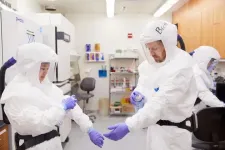(Press-News.org) SAN FRANCISCO, CA--June 21, 2021--The progression from a round ball of cells to an embryo with a head and a tail is one of the most critical steps in an organism's development. But just how cells first start organizing themselves with directionality along this head-to-tail axis is hard to study because it happens in the earliest days of embryonic development, in the confines of a mammal's uterus.
Now, scientists at Gladstone Institutes have created an organoid--a three-dimensional cluster of cells grown in the lab--that mimics the earliest developmental steps of the nervous system in embryos. The organoid is the first to show how human spinal cord cells become oriented in an embryo, and could shed light on how environmental exposures or toxins can make this process go awry, causing early miscarriages and birth defects.
"This is such a critical point in the early development of any organism, so having a new model to observe it and study it in the lab is very exciting," says Gladstone Senior Investigator Todd McDevitt, PhD, senior author of the new paper published in the journal Development.
In a weeks-old human embryo, cells destined to become the backbone and spinal cord start assembling--beginning at the embryo's head end and growing to form the tail (or tailbone) end of the embryo. The process is known as axial elongation.
Although scientists have studied this process in chick and mouse embryos, they have not been able to study molecules that help signal "heads" or "tails" to cells. What's more, differences in the body plans of humans compared to other animals--such as the lack of a tail--might mean that observations in these model organisms don't hold true in humans.
Members of McDevitt's team were working on a new organoid, made from a population of brain cells, when they noticed that certain conditions allowed cell clusters to begin to spontaneously elongate, forming tadpole-shaped structures reminiscent of developing spinal cords. The extended organoids had made the same transition that an embryo undergoes when the spinal cord develops--switching from a ball of cells to something with a distinct head and a tail, marking the top and bottom of the spine.
"Organoids don't typically have head-tail directionality, and we didn't originally set out to create an elongating organoid, so the fact that we saw this at all was very surprising," says Gladstone Graduate Student Nick Elder, a co-author of the new paper along with fellow Graduate Student Emily Bulger and former Graduate Students Ashley Libby, PhD, and David Joy, PhD.
The researchers worked to narrow down exactly what made the organoid elongate, and homed in on a handful of required signaling molecules. Then, they analyzed which genes were turned on or off in cells throughout the elongating organoid over the course of about 2 weeks. They found that the organoid had cellular and molecular patterns similar to those previously found in early developing mouse embryos.
"That means we can now use this model to better dissect the cellular and molecular details of human spinal cord elongation in the developing embryonic environment," says Bulger.
For instance, the researchers used CRISPR-Cas9 genome-editing technology to silence a gene from stem cells thought to be important in spinal cord development, and then created organoids from the edited cells. Without the gene, the team showed, the organoids didn't elongate normally, verifying the importance of the gene in axial elongation.
The organoid model could also be used to screen drugs or environmental exposures for their effect on a developing embryo, the researchers say.
"We can use this organoid to get at unresolved human developmental questions in a way that doesn't involve human embryos," says Libby. "For instance, you could add chemicals or toxins that a pregnant woman might be exposed to, and see how they affect the development of the spinal cord."
For now, McDevitt's team is planning to continue refining their approach to create elongating organoids under different conditions and using different cell types in an attempt to further understand the complex interactions that are required to build the spinal cord.
INFORMATION:
About the Study
The paper "Axial Elongation of Caudalized Human Organoids Mimics Aspects of Neural Tube Development" was published by the journal Development on June 18, 2021: https://journals.biologists.com/dev/article-abstract/148/12/dev198275/269182/Axial-elongation-of-caudalized-human-organoids?redirectedFrom=fulltext.
Other authors of the paper are Martina Z. Krakora, Federico Mendoza-Camacho and Jessica C. Butts of Gladstone; and Eliza A. Gaylord of UC San Francisco.
The work at Gladstone was supported by the California Institute of Regenerative Medicine (LA1_C14-08015) and the National Science Foundation (CBET 0939511), as well as a fellowship from the National Heart, Lung, and Blood Institute (1F31HL140907-01).
About Gladstone Institutes
To ensure our work does the greatest good, Gladstone Institutes focuses on conditions with profound medical, economic, and social impact--unsolved diseases. Gladstone is an independent, nonprofit life science research organization that uses visionary science and technology to overcome disease. It has an academic affiliation with the University of California, San Francisco.
A study conducted in the Una Biological Reserve in the state of Bahia, Brazil, shows that in a habitat with high hunting pressure the risk of predation has such a significant impact on the behavior of the Yellow-breasted capuchin monkey Sapajus xanthosternos that it even avoids areas offering an abundant supply of plant biomass and invertebrates, its main sources of food.
An article reporting the findings of the study is published in the American Journal of Primatology.
"Many theories in the field of primatology assume that pressure to find food is more important that predation pressure. In this study we were able ...
A high body mass index (BMI) during adolescence is a significant risk factor for Type 2 diabetes, early heart attack and overall poorer health for young adults, regardless of BMI in adulthood, according to a research letter published today in the Journal of the American College of Cardiology.
BMI is calculated based on weight and height. According to the National Heart, Lung, and Blood Institute, BMI categories are defined as: less than 18.5 kg/m2 is underweight; 18.5 to 24.9 is normal weight; 25 to 29.9 is overweight; and 30 or greater is obese.
Researchers analyzed the BMI z-scores, which is relative weight adjusted for a child's age and sex, of 12,300 adolescents ...
Data captured in NCDR registries is similar in quality, depth and granularity when compared to data captured through clinical trials, according to research in JACC: Cardiovascular Interventions that compared data from the DAPT Study to NCDR CathPCI Registry data. This is good news for streamlining data collection and supports recent efforts to standardize data elements and definitions used in clinical trials and registries.
"We found an overall high level of similarity in data between these two sources. This suggests that registries may also be suitable to support baseline data collection for many clinical studies," said senior study author Robert W. Yeh, MD, MSc, director of the Richard A. and Susan F. Smith Center for Outcomes Research in Cardiology ...
The use of statin therapy in adults 65 years old or older is not associated with incident dementia, mild cognitive impairment (MCI) or decline in individual cognition domains, according to a study published in the Journal of the American College of Cardiology (JACC).
Cognitive decline and dementia are major health concerns in older individuals, affecting about 10% of people over 60 years old. Statins are used to reduce low-density lipoprotein cholesterol, or bad cholesterol, thus they are a fundamental treatment for prevention of primary and secondary cardiovascular disease (CVD) events. The Food and Drug Administration released a warning in 2012 about cases of apparent short-term ...
It's a treasure trove of data: the global geodatabase of vegetation plots "sPlotOpen" is now freely accessible. It contains data on vegetation from 114 countries and from all climate zones on Earth. The database was compiled by an international team of researchers led by Martin Luther University Halle-Wittenberg (MLU), the German Centre for Integrative Biodiversity Research (iDiv) and the French National Centre for Scientific Research (CNRS). Researchers around the world finally have a balanced, representative dataset of the Earth's vegetation at their disposal, as the team reports in the journal Global Ecology & Biogeography.
Global issues and questions require global answers. "If we want to understand or predict how climate ...
June 21, 2021 -- A new study published in Nutrients investigated the effect of increased dietary potassium from a whole food source--baked/boiled potatoes and baked French fries--or a potassium supplement on blood pressure and other cardiovascular disease risk factors compared to a 'typical American' control diet (lower potassium intake) among 30 pre-hypertensive to hypertensive men and women. Results showed that including baked/boiled potato consumption as part of a typical American diet had the greatest benefit on reducing sodium retention, even more than the supplement, and resulted ...
COVID-19 therapies made from antibodies often are given to patients who are at high risk of severe illness and hospitalization. However, there have been nagging questions about whether such antibody therapies retain their effectiveness as worrisome new virus variants arise.
New research at Washington University School of Medicine in St. Louis suggests that many, but not all, therapies made from combinations of two antibodies are effective against a wide range of variants of the virus. Further, combination therapies appear to prevent the emergence of drug resistance.
The study, in mice and hamsters, tested all single and combination antibody-based therapies authorized for emergency use ...
HOUSTON - (June 21, 2021) - Diamond may be just a phase carbon goes through when exposed to a flash of heat, but that makes it far easier to obtain.
The Rice University lab of chemist James Tour is now able to "evolve" carbon through phases that include valuable nanodiamond by tightly controlling the flash Joule heating process they developed 18 months ago.
Best of all, they can stop the process at will to get product they want.
In the American Chemical Society journal ACS Nano, the researchers led by Tour and graduate student and lead author Weiyin Chen show that adding organic fluorine compounds and ...
LAWRENCE -- Tulsa may not be the first town one thinks of when talking about jazz, and flood management may not be the first vocation one compares to the musical genre. But the success Tulsa displayed in going from one of the nation's most flood-prone cities to a nationally recognized model of long-term risk reduction in just two decades is analogous to the evolution of one of the most American styles of music, a University of Kansas professor points out in a new study.
Tulsa, the second-largest city in Oklahoma, suffered several devastating floods in the 1970s and 1980s, then became a national model for flood mitigation by the 1990s. What hasn't been studied closely is how a group of engineers, planners, government officials, journalists, attorneys and citizens came together ...
The word "tsunami" brings immediately to mind the havoc that can be wrought by these uniquely powerful waves. The tsunamis we hear about most often are caused by undersea earthquakes, and the waves they generate can travel at speeds of up to 250 miles per hour and reach tens of meters high when they make landfall and break. They can cause massive flooding and rapid widespread devastation in coastal areas, as happened in Southeast Asia in 2004 and in Japan in 2011.
But significant tsunamis can be caused by other events as well. The partial collapse of the volcano Anak Krakatau in Indonesia in 2018 caused a tsunami that killed more than 400 people. Large landslides, which send immense amounts of debris into the sea, also ...



